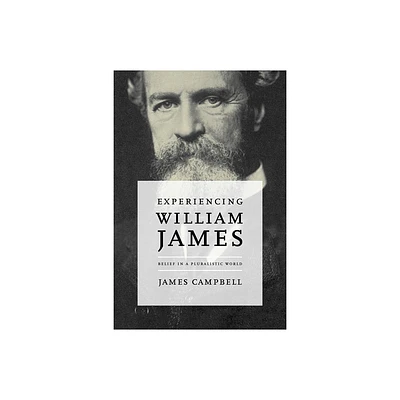Home
The Correspondence of William James: April 1908-August 1910
Loading Inventory...
Barnes and Noble
The Correspondence of William James: April 1908-August 1910
Current price: $95.00


Barnes and Noble
The Correspondence of William James: April 1908-August 1910
Current price: $95.00
Loading Inventory...
Size: OS
*Product Information may vary - to confirm product availability, pricing, and additional information please contact Barnes and Noble
This twelfth and final volume of The Correspondence of William James concludes the series of William James’s correspondence with family, friends, and colleagues that began with volume 4. The first three volumes were devoted to the letters exchanged between the brothers William and Henry James. Consisting of some 600 letters, with an additional 650 letters calendared, this final volume gives a complete accounting of James’s known correspondence from April of 1908 to 21 August 1910, inclusive, the last letter having been written five days before James’s death on 26 August 1910. The volume also accounts for undated letters, as well as letters located too late to be included in their proper chronological place in the preceding volumes.
The correspondence takes place against a background of aging and illness. First came Henry’s collapse in the spring of 1910, which led William and Alice to undertake their last voyage to Europe. Leaving wife and brother in England, William journeyed to Paris in hopes that a doctor there could ease the pain in his chest, and then to Bad-Nauheim. There, although the results from X rays and measurements of his blood gave him hope, his condition did not improve. William wandered around Europe, joined by his wife and brother, before boarding a steamer for Montreal. By then an invalid, unable on most days to make even simple entries in his diary, he traveled from Quebec to Chocorua, where he died in the arms of his wife.
Professionally there are three major events during this period in James’s life. First was the delivery at Manchester College, Oxford, of the Hibbert Lectures on the present condition of philosophy, published in 1908 as A Pluralistic Universe. As was his habit, James sent numerous complimentary copies of his book and received many thoughtful responses, which provide a rare opportunity to see how differently diverse readers interpret the same book. Next came publication of The Meaning of Truth, which forced James to return to the defense of the pragmatic conception of truth. The third was his work on a textbook in metaphysics that was to become the posthumously published Some Problems of Philosophy.
Most of James’s philosophical correspondents remain the same as in the previous volume: John Dewey, Henri Bergson, Francis Herbert Bradley, Ferdinand Canning Schiller, Charles Sanders Peirce, Ralph Barton Perry, William Pepperell Montague, Horace Meyer Kallen, Arthur Oncken Lovejoy, Charles Augustus Strong, and Dickinson Sergeant Miller. With the French philosopher Émile Boutroux and the German pragmatist Julius Goldstein there is more extensive correspondence in this volume than in the previous one. Sigmund Freud, while not a correspondent, makes a cameo appearance when he and James meet in the fall of 1909 at Clark University.
The correspondence takes place against a background of aging and illness. First came Henry’s collapse in the spring of 1910, which led William and Alice to undertake their last voyage to Europe. Leaving wife and brother in England, William journeyed to Paris in hopes that a doctor there could ease the pain in his chest, and then to Bad-Nauheim. There, although the results from X rays and measurements of his blood gave him hope, his condition did not improve. William wandered around Europe, joined by his wife and brother, before boarding a steamer for Montreal. By then an invalid, unable on most days to make even simple entries in his diary, he traveled from Quebec to Chocorua, where he died in the arms of his wife.
Professionally there are three major events during this period in James’s life. First was the delivery at Manchester College, Oxford, of the Hibbert Lectures on the present condition of philosophy, published in 1908 as A Pluralistic Universe. As was his habit, James sent numerous complimentary copies of his book and received many thoughtful responses, which provide a rare opportunity to see how differently diverse readers interpret the same book. Next came publication of The Meaning of Truth, which forced James to return to the defense of the pragmatic conception of truth. The third was his work on a textbook in metaphysics that was to become the posthumously published Some Problems of Philosophy.
Most of James’s philosophical correspondents remain the same as in the previous volume: John Dewey, Henri Bergson, Francis Herbert Bradley, Ferdinand Canning Schiller, Charles Sanders Peirce, Ralph Barton Perry, William Pepperell Montague, Horace Meyer Kallen, Arthur Oncken Lovejoy, Charles Augustus Strong, and Dickinson Sergeant Miller. With the French philosopher Émile Boutroux and the German pragmatist Julius Goldstein there is more extensive correspondence in this volume than in the previous one. Sigmund Freud, while not a correspondent, makes a cameo appearance when he and James meet in the fall of 1909 at Clark University.


















